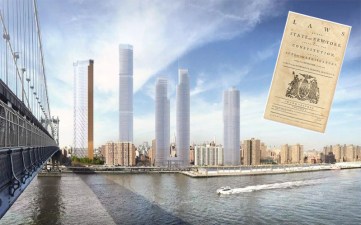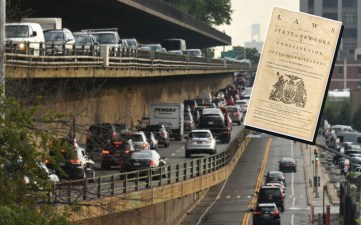Manhattan Judge Tosses ‘Green Amendment’ Lawsuit Against Two Bridges Mega-Development

A Manhattan judge has tossed out a lawsuit attempting to stop a Lower Manhattan development on the grounds that it would infringe upon New Yorkers’ new constitutional right to clean air and water — the first-ever decision in a New York City case involving the so-called “green amendment.”
The lawsuit against the Two Bridges complex claimed that the development and construction process would violate residents’ new constitutional right to clean air and water because it would eliminate some parking spaces, and add density and traffic, especially in a low-income community of color that already suffers from high rates of asthma.

But Manhattan Supreme Court Justice Arlene Bluth, in her April 17 decision, wrote that some of what plaintiffs fear is not actually a violation of their constitutional rights, but just a part of living in the Big Apple. She also added that it’s a good thing that the development would reduce parking, hopefully encouraging more public transit use.
“The complaint … contains varying alleged harms, some of which are simply part of living in Manhattan,” wrote Bluth. “Plaintiffs complain about a lack of parking (which may actually encourage the use of public transportation although plaintiffs apparently claim it will lead to increased driving, possibly while looking for a spot) before complaining about increased carbon dioxide emissions.”
The case — which was filed in October by the Asian American Legal Defense and Education Fund on behalf of 12 plaintiffs and the local Council Member Christopher Marte — was the latest in a string of lawsuits against the controversial project, which includes towers of 80, 69 and 62 stories next to an existing 80-story tower at 225 Cherry St. The development comprises about 2,775 new units, roughly 25 percent of which, or 694, would be priced below market rate, including 200 units set aside specifically for low-income senior housing. It would also include new amenities like community facility space, retail, outdoor space, according to the project documents.

The development has snaked its way through the legal system for more than six years, and each time, the courts have ruled in favor of the developers. Bluth’s main contention against the lawsuit, referring to it as “yet another ‘bite at the apple,’” was that the courts have already decided the project’s fate after going through the lengthy environmental review process known as the State Environmental Quality Review Act, or SEQR, more than four years ago, and that nothing in its blueprint has changed significantly enough to warrant a new analysis.
As such, Bluth admitted she was not ruling on the merits of the suit’s use of the “green amendment,” a constitutional provision guaranteeing every resident’s right to clean air and water that passed overwhelmingly in 2021.
“The Court makes no finding that concerns about air quality are unfounded. It simply finds that such a concern was addressed in the environmental analysis and there is no basis to revisit it here,” she wrote.
Other lawsuits citing the green amendment have been filed upstate, including against the permitting of a waste transfer station in upstate Cayuta, but the one against Two Bridges was the first in the city.
Regardless of the fact that Bluth did not rule on the merits, she strongly expressed her individual opinion on the inappropriateness of using the green amendment to stop a dense urban development. And she said she “hesitates to create a brand-new route to challenge developments on an environmental basis, which is exactly what plaintiffs’ action would entail.”
Her dismissal also echoed the concerns of affordable housing advocates who feared that the lawsuit, if won, could set a dangerous precedent for stopping other much-needed development projects.
“Plaintiffs’ purported environmental harms are, for the most part, the types of harms traditionally raised by those who oppose construction projects,” Bluth wrote. “But those valid arguments do not create a substantive basis for this action or require the city to revisit the completed environmental reviews for this project. As [one of the developers] points out, if the green amendment could be used to create a way to reopen previously unsuccessful efforts, then countless projects would be ripe for challenge.”
She also argued that the amendment was primarily written to give New Yorkers the legal standing to stop environmental harms caused by projects like waste transfer stations and toxic landfills, not housing.
“The construction of these buildings does not evince the same sort of environmental concerns that might accompany, for example, a landfill or toxic waste site,” Bluth said.
An environmental lawyer who is not involved in this specific case dismissed Bluth’s dismissal as merely “procedural.”
“The judge talked about a number of things, some of it does go into the substance of the case, but really what the judge is deciding on was more of a procedural decision, which is that the green amendment can’t be used to bring up another challenge that was already brought and basically lost,” said Sonya Chung, a staff attorney at New York Lawyers for the Public Interest, which supports the “community’s long fight against gentrification and development without meaningful community engagement and leadership.”
Attorney Jack Lester, who is representing the plaintiffs, vowed an appeal.
“The court misinterpreted the green amendment. It failed to apply the newly enacted constitutional amendment to the facts and circumstances of the Two Bridges development project,” he told Streetsblog. “She said the people who are suing had already lost in court in prior court cases and therefore she didn’t want to reopen the case. She just dismissed it given that there were prior cases.
“I just think the court didn’t have a complete understanding … because it’s new and it’s never been litigated previously in New York County,” he added.
A spokesperson for the city Law Department said the agency is “pleased with the ruling and will defend it on appeal.”

